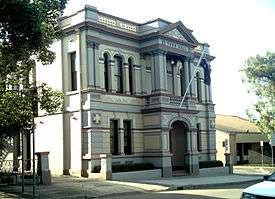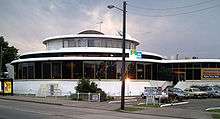Granville, New South Wales
| Granville Sydney, New South Wales | |||||||||||||
|---|---|---|---|---|---|---|---|---|---|---|---|---|---|
 Granville Town Hall and public library (right) | |||||||||||||
| Population | 13,989 (2011 census)[1] | ||||||||||||
| Established | 1855 | ||||||||||||
| Postcode(s) | 2142 | ||||||||||||
| Location | 22 km (14 mi) W of Sydney CBD | ||||||||||||
| LGA(s) | |||||||||||||
| State electorate(s) | Granville | ||||||||||||
| Federal Division(s) | Parramatta | ||||||||||||
| |||||||||||||
Granville is a suburb in western Sydney, in the state of new South Wales, Australia. Granville is located 22 kilometres (14 mi) west of the Sydney central business district, split between the local government areas of Cumberland Council and the City of Parramatta.
South Granville is a separate suburb with the distinguishing feature of a light industrial area. Lisgar, Redfern, Heath and Mona Streets form the approximate border between Granville and South Granville. The Duck River provides a boundary with Auburn, to the east.
History
Granville was named in 1880, after the British Colonial Secretary, the Granville Leveson-Gower, 2nd Earl Granville.[2]
The area evolved primarily after 1855, when it became the final stop of the first railway line of New South Wales. The Sydney-Parramatta Line ran from Sydney terminus, just south from today's Central railway station to the Granville area which was originally known as 'Parramatta Junction'. This led to the development of this area, which attracted speculators and some local industries.
In the early days of European settlement, timber was harvested to fuel the steam engines in Sydney and Parramatta. By the 1860s, the supply of timber was exhausted. The remainder was used by scavengers who made a living by collecting firewood. Wattle bark found use with tanners and the bark from stringybark trees was used for roofing of huts. In 1862, a major estate, Drainville, became subject to a mortgagee sale and subdivided for villa homes, and small agricultures. At the end of the decade a Tweed Mill was established, which was steam powered using water from the Duck River.
In 1878, the locality received its own post office, which was then part of the stationmasters house. In 1880 Parramatta Junction was renamed to Granville, after the British Colonial Secretary, Granville Leveson-Gower, 2nd Earl Granville. The place then had a population of 372, of which 176 were male and 196 female. In this era some German settlers, Joseph Klein and P W Merkell, tried to establish vineyards in the area, but eventually found the land was not suited for this type of agriculture. More farmers discovered the limitations of the local soils and fruit growers complained about the damage from flying foxes. Thus, the only practical use for the grasslands, which replaced the original bushland, was for dairy cattle.
The Granville Municipality was formed in 1885 and the council carried on the local government of the area until 1948, when it became part of an enlarged City of Parramatta.
On Anzac Day of 1974, Granville was partially severed by flooding of the Duck Creek stormwater channel due to torrential rain that fell over the area. 135 millimetres of rain fell between 11.30 pm and 12.30 pm at Guildford, with the ensuing flood doing major damage through Granville.[3] The nearby RSL underwent damage and many of the club's old photographs and honour boards were destroyed.
Granville is also the location of the Granville railway disaster, which occurred on 18 January 1977 when a commuter train derailed just before the Bold Street overpass and hit the staunchion, causing the bridge to collapse. 83 people perished, making it the worst rail disaster in Australian history.[4]
Buildings and places of interest

Granville has a mixture of residential, commercial and industrial developments. The commercial and residential developments are mostly around Granville railway station and Parramatta Road. Granville is primarily dominated by freestanding weatherboard, fibro and unrendered brick buildings. The area is no longer exactly "typical" quarter acre block territory, but 500 to 600 m2 (0.12 to 0.15 acres) blocks are reasonably common. Terraced houses are rare, but increasing in number. Apartment blocks, generally three to four storeys in height, are also becoming more common in the vicinity of the railway station.
Buildings that deserve some attention are:
- Granville Town Hall, which was built in 1888
- The Royal Hotel corresponds with the architecture of the Town Hall about 200 m away
- The Brianna's function centre building just north of the railway station on Good Street
- St. Marks Anglican Church dates back to 1882
- St. Aphanasius Church, a Ukrainian Autocephalic Orthodox with onion domes, adds some interest to William Street. It dates back to 1956.
- The White Palace in South Street has an exterior with Art Deco features. The building was gutted and redeveloped in 2007.
- The intersecting circles of Granville RSL Sub-Branch Building serves as an interesting example of modern architecture. It was designed by Frank Fox & Associates.
Crest Theatre
The Crest building on the corner of Blaxcell and Redfern Streets, was built by Hoyts in 1948 as a movie theatre and was used for screening movies up until 1963. The structure of the building is of a Quonset hut design, while the facade and interior is of a post-Art Deco and post-Moderne eclectic style,[5] influenced by the "Picture Palace" architecture popularly used for movie theatres. It is now used as a function hall.
The Crest Theatre is now listed in the NSW State Heritage Register as being of "State significance", being one of the few cinemas built in Australia in the 1940s.[5] Externally and internally the building remains largely intact, though the signage on the external decorative pier now reads "B-L-O-U-Z-A",[6] rather than the original "H-O-Y-T-S" (later it was "B-I-N-G-O").
Transport
Trains
Granville railway station is a major station on the South Line and Western Line of the Sydney Trains network. The station is wheelchair accessible. Granville railway station is located on the Main Suburban line. It is served by Sydney Trains T1 Northern and Western Lines and T2 Inner West & South Line services and NSW TrainLink Blue Mountains Line services. Granville's newly built bus interchange, as well as a car park, are located adjacent to its train station. Bike racks and lockers are located nearby. Taxi ranks can be found just south of the train station.[7]
Bus
Granville is serviced by Transdev NSW and features a newly built bus interchange. Transdev NSW operates three bus routes via Granville railway station:
- 906: Parramatta station to Fairfield station[8]
- M91: Parramatta station to Hurstville[9]
- S2: to Sefton[10]
Granville station is served by one NightRide (Night Bus) route:[11]
- N60: Fairfield station to City (Town Hall)
Road
Parramatta Road has always been an important thoroughfare for Sydney from its earliest days. From Parramatta the major western road for the state is the Great Western Highway. The M4 Western Motorway, running parallel to the Great Western Highway has taken much of the traffic away from these roads, with entrance and exit ramps close to Parramatta.
Education
Granville has a major college of Technical and Further Education, which is part of the South Western Sydney Institute of TAFE. Schools include Granville Boys High School which was founded in 1926, Delany College, Granville Public School, Granville East Public School, Blaxcell Street Public School and Holy Family Catholic School. The suburb is also home to a Cumberland Council branch library.
Culture
Entertainment

The suburb boasts four pubs. The Royal Hotel and the Granville Hotel are located south and north of the railway line respectively. The Rosehill Hotel is located on the northern side of Parramatta Road and the Vauxhall Inn is on the same street on the western edge of Granville on the corner of Woodville Road. Granville is also home to a sub-branch club of the RSL, known as Granville Diggers.[12] Attractions include live music, bingo, karaoke etc.
Sport
Granville has an Olympic size pool and a football facility. Historic Garside Park is home to State Super League and Super Youth League club, Granville Rage.
Sydney Speedway is a 460 metres (500 yards) dirt track speedway which opened in 1977 at the old Granville Showground as the Parramatta Speedway. The clay surface caters mainly to Sprintcars and has been home to some of Australia's greatest drivers including ten times Australian Sprintcar Champion Garry Rush, and multiple title holders George Tatnell, his son Brooke Tatnell, and Max Dumesny. The speedway is also the only venue not in North or Central America to host a round of the famous World of Outlaws sprintcar series.
Population
At the 2011 census, there were 13,989 residents in Granville. More than half of people were born outside of Australia, with the top countries of birth being India, China and Lebanon. Three-quarters of people spoke a language other than English at home. The most common other languages spoken at home were Arabic 18.1%, Cantonese 5.5% and Mandarin 4.8%. The housing in Granville was evenly spread between detached houses and higher density units or apartments. 46.3% of residents were renting their home and this was higher than the national average of 29.6%.[1]
Notable residents
Pete Graham Radio announcer, Born 1951. The highest rating announcer on 2ws.Started " Juke Box Saturday Night. Civic and charity worker. Awarded Variety Club heart award. Holroyd Citizen Award, Baulkham Hills Shire Citizen award.Currant host on Fairfax radio.
- John Devitt (born 1937), Olympic gold medallist and manager of the Australian Commonwealth Games team grew up in Granville[13]
- Jack Ferguson (1924–2002), Former deputy premier of New South Wales
- Paul Hogan (born 1939), actor, grew up in Granville[13]
- Hillal Kara-Ali (born 1990), winner of the sixth season of the Australian version of The Mole[14]
- Bernie McGann (1937–2013), Saxophonist who was born in Granville
- Judy Stone (born 1942), Australian pop singer, was born and raised in Granville
- Robert Taylor (born 1957), General manager of Melbourne's National Theatre, was raised in Granville attending both Granville Primary School and Granville Boys' High School
- Roland Stuart Andrews (1897–1961), Industrial Chemist and Administrator[15]
See also
| Wikimedia Commons has media related to Granville, New South Wales. |
- Electoral district of Granville
- South Granville, New South Wales
- Granville railway station
- Granville railway disaster
References
- 1 2 Australian Bureau of Statistics (31 October 2012). "Granville (State Suburb)". 2011 Census QuickStats. Retrieved 5 May 2013.
- ↑ Granville: From Forest to Factory, John Watson (ed.), 1992, Granville Historical Society.
- ↑ Duck Creek – Flooding File, Sydney Water.
- ↑ Parramatta – a Past Revealed, Terry Kass, Carol Liston, John McClymot, 1996, Parramatta City Council.
- 1 2 "Crest Theatre" listing on the NSW State Heritage Register.
- ↑ History of the Crest Theatre
- ↑ http://www.sydneytrains.info/stations/station_details.htm
- ↑ "Route 906 timetable" (PDF). Transdev NSW. 27 April 2015.
- ↑ "Route M91 timetable" (PDF). Transdev NSW. 20 April 2015.
- ↑ "Routes 908 and S2 timetable" (PDF). Transdev NSW. 27 April 2015.
- ↑ NightRide bus services Transport Info NSW
- ↑ http://www.granvillediggers.com.au/#/home/
- 1 2 http://www.parliament.nsw.gov.au/prod/parlment/hansart.nsf/V3Key/LA20071107038
- ↑ Is Granville's Hillal Kara-Ali the mole?, The Daily Telegraph, 3 July 2013
- ↑ "Australian Dictionary of Biography". adb.anu.edu.au. Retrieved 2015-08-03.
External links
- Council of the City of Parramatta
- Granville Historical Society
- "Granville". Dictionary of Sydney. 2008. Retrieved 27 September 2015. [CC-By-SA]
Coordinates: 33°50′25″S 151°00′28″E / 33.84040°S 151.00790°E
